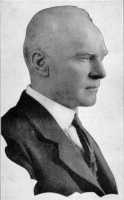BIOGRAPHY

He was said to be the fifth most famous person in North America. He was "The Father of Conservation", the man who tracked 50,000 wild ducks, and who addressed the world with his message of conservation. The fact that National Wildlife week is on his birthday comes as no surprise.
|
The Story of Jack Miner begins in Dover Center, Ohio. Born on April 10th, 1865, Jack only attended school for three months. The outdoors were said to be his classroom. In his free time, he would wander around the creeks and woods, studying the habits of wildlife. In 1878, when Jack was thirteen, his family moved to Gosfield South Township near Kingsville, Ontario. In order to pitch in, and contribute to his family's income, he became a trapper and market hunter. He became very proficient at hunting, and helped his family a great deal. However, with the unending development of the surrounding region, the declining quality of the Great Lakes, and most of all, the threat of wildlife extermination, Jack Miner slowly became aware of the need for conservation.
His realization of conservation led him to formation of the first "Game Protective Association". This started Jack Miner's leap to the forefront of conservation. In 1904, Jack founded the Jack Miner Bird Sanctuary for the conservation of migrating Canada Geese and wild ducks. This was the origin of the waterfowl refuge management system. In 1906, Jack was dubbed "The Father of Conservation" by the Minneapolis Journal.
By August 1909, Miner tagged his first wild duck with a hand stamped aluminum band. Five months later, the band was recovered by Dr. W. Bray of Anderson, South Carolina. This was the first complete banding record. This was the pioneering of the tagging of migratory waterfowl. Over the next six years, data from thousands of subsequent taggings were instrumental in the Migratory Bird Treaty of 1916 between Canada and the U.S.
So began Jack Miner's lecturing career. He became one of the most sought out conservationalist lecturers. He spoke of the need for the establishment of sanctuaries and wildlife refuges and lectured on wildlife conservation. Jack Miner spoke throughout North America, and over the next thirty years, he would devote his time to create awareness for conservation.
|
|
By 1915, Jack Miner branded his first Canadian Goose, in order to track their migrational habits. At this time, a Biblical verse was inserted into each band making the geese, "Missionaries of the air." In 1916, the data from tagging recoveries proved instrumental in the Migratory Bird Treaty that was signed by the United States and Canada. The Act placed the first restrictions on hunting, assuring protection for the waterfowl population of the future.
In 1919, Jack published his first book, "Jack Miner and the Birds". This was a personal victory for Jack Miner because of his lack of education. In 1929, Jack was awarded the Outdoor Life Gold Medal for the greatest achievement in wildlife conservation on the continent. This was the first time the award had ever been presented to a Canadian.
The Jack Miner Migratory Bird Foundation was created in 1931, under US philanthropic law, which was later incorporated in 1936 by a special act of the Ontario Legislature. It was at this time, that Jack Miner was given his greatest opportunity. Prime Minister MacKenzie King chose Miner to deliver the around the world radio address for the 25th anniversary of King George's reign as monarch. After Jack Miner's awe inspiring speech, he received letters from sixty-five countries around the world praising him for his excellence. King George recognized Miner's achievements in 1943 when he was presented with the Order of the British Empire for the "Greatest achievement in conservation in the British Empire."
In all his fame, Jack Miner left the world with absolute greatness for what he truly believed to be the most important thing in the world: conservation. Jack Miner died on November 3, 1944. Over his lifetime, he had branded 50,000 wild ducks, and 40,000 migratory Canada geese. He was ranked the fifth best known man on the continent after Henry Ford, Thomas Edison, Charles Lindbergh and Eddie Rickenbacker. After his death, Jack's legacy lived on. In 1947, Canada's National Wildlife Week was passed unanimously. It was to be observed the week of April 10th -- Jack's birthday. This is Jack's everlasting memorial. In the same year, Jack was named, "one of fifteen great personages of the world," by the Book of Knowledge. Jack Miner was a hero, and a pioneer in the world of conservation.
|
 Home > Basic > Publications > Jack Miner
Home > Basic > Publications > Jack Miner

 Return to Top
Return to Top Home > Basic > Publications > Jack Miner
Home > Basic > Publications > Jack Miner

 Return to Top
Return to Top